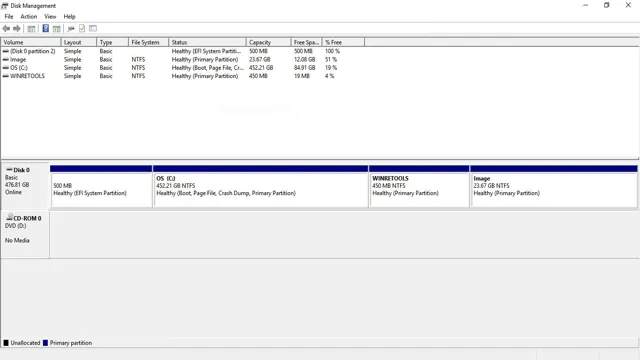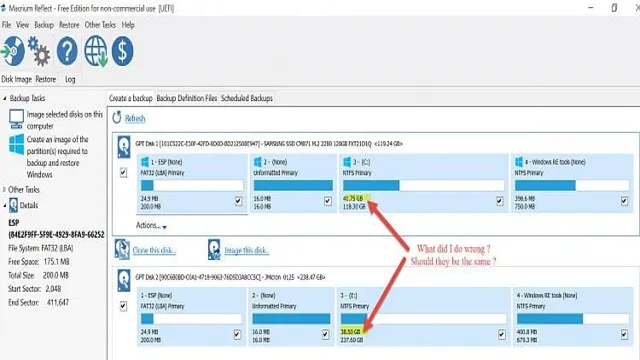When it comes to building a new PC or upgrading your existing one, choosing the primary drive is one of the most important decisions you can make. The primary drive is where your operating system and most frequently used programs are stored, so it’s crucial that you choose the right one to ensure optimal performance. With so many options available, the decision can be overwhelming.
Do you go for a traditional hard disk drive or opt for a solid-state drive? How much storage space do you need? And what about the price? In this blog post, we’ll walk you through everything you need to know to make an informed decision and choose the primary drive that’s perfect for your needs. So sit back, relax, and let us guide you through the process.
Understanding Cloned SSDs
When it comes to cloned SSDs, one important aspect to consider is choosing the primary drive. This is the drive that your computer will automatically boot from, and ideally, it should be the one with the faster read and write speeds. But how do you determine which drive is faster? One way is to check the specs of both drives and compare their read and write speeds.
Another way is to use benchmarking software to run tests on both drives and see which one performs better. Ultimately, the best approach will depend on your specific needs and preferences. But by taking the time to choose the right primary drive, you can ensure that your computer is running at maximum speed and efficiency.
What is a Cloned SSD?
A cloned SSD is essentially a copy of an existing SSD drive. It is created by duplicating all the data and information stored on the original SSD and transferring it onto a new SSD. This process is often used when upgrading to a larger or faster SSD, or when replacing a failing or corrupted SSD.
Cloning an SSD can also be beneficial if you want to transfer all your files and data from one computer to another without having to manually re-install all your programs and applications. Essentially, a cloned SSD is an exact replica of the original, but with all the benefits of a fresh install. By cloning an SSD, you can enjoy faster boot times, improved performance, and increased storage capacity, all without having to start from scratch.
Whether you’re a professional or a casual user, a cloned SSD can be a powerful tool that can help you get more out of your computing experience.

Advantages of Cloning SSDs
Cloning SSDs can be an incredibly beneficial process in computer maintenance. An SSD clone is an exact copy of an existing SSD, meaning that all the data, configurations, and settings from the original drive are copied over to the clone. There are several advantages to cloning SSDs, including quicker data transfer speeds, improved system performance, and increased data protection.
When cloning SSDs, the new drive can be easily swapped with the old drive, allowing for a seamless transition without the need for reinstallation or system configuration. Additionally, cloning an SSD also allows for easy backup and recovery, as the cloned drive can serve as a backup in case the original drive malfunctions or fails. Overall, understanding cloned SSDs can help computer users increase their device’s overall lifespan, prevent data loss, and improve system performance.
Factors to Consider in Choosing Primary Drive
If you’ve cloned your SSD and need to choose a primary drive, there are some factors to consider. Firstly, you’ll want to look at the size and capacity of the drives. You want to ensure that your primary drive has enough space to handle your operating system and essential applications without running out of space quickly.
The next thing to consider is the speed of the drive. An SSD is much faster than a traditional hard drive, but you’ll want to ensure that you’re choosing the fastest SSD within your budget. Finally, you’ll want to think about reliability.
It’s essential to choose a drive from a reputable brand with a good track record to ensure that your data will be safe and secure. By taking these factors into consideration, you can select the perfect primary drive for your cloned SSD that will provide the performance you need and the reliability you can trust. So, when choosing a primary drive, always remember to look at the size, speed, and reliability to ensure that you’re making the best decision for your needs.
User Needs and Preferences
When it comes to choosing a primary drive for your computer, there are several factors to consider. First and foremost, you need to think about your user needs and preferences. If you are a casual user who mostly uses their computer for browsing the internet and doing basic tasks, then a solid-state drive (SSD) would be a good option for you.
An SSD is faster and more reliable than a traditional hard drive, making it ideal for everyday use. On the other hand, if you are an avid gamer or a professional who requires a lot of storage space and wants to run programs quickly, then a hard disk drive (HDD) might be a better choice. HDDs have larger capacities and are better suited for heavy-duty tasks.
It’s important to think about your computing needs and choose the type of drive that best fits your requirements.
Disk and Partition Configuration
When choosing a primary drive, there are several factors that should be taken into consideration. The first is the amount of storage space needed. It’s important to choose a drive that has enough space for all of your files and applications, as running out of space can cause performance issues.
The type of drive is also a consideration, as solid-state drives (SSDs) are faster and more reliable than traditional hard drives. Additionally, the interface used by the drive can affect performance, with SATA being slower than newer interfaces like NVMe. Finally, it’s important to consider the manufacturer and any warranty or support offered, as this can impact the longevity and reliability of the drive.
By carefully considering these factors and choosing a high-quality primary drive, you can ensure that your system runs smoothly and reliably.
Boot Order and BIOS Settings
When it comes to choosing the primary drive for your system, there are several factors to consider. One important consideration is the boot order and BIOS settings. The BIOS, or Basic Input/Output System, is a software built into your computer’s motherboard.
It helps control several crucial aspects of your computer’s hardware, including the boot order. The boot order determines which device your system boots from first. For instance, you can set it to boot from your hard disk drive (HDD), solid-state drive (SSD), USB drive or optical drive.
To prioritize the device you’re using as your primary drive, follow these steps: Restart your computer and enter the BIOS. Look for the boot order settings and adjust accordingly. The primary drive should be set to the device with the operating system installed on it to ensure your computer boots properly.
Remember to save your changes before exiting the BIOS. Doing so will ensure that your system boots from your primary drive first, so you can access your files and applications quickly.
How to Choose Primary Drive
When cloning an SSD, selecting the primary drive can be crucial to ensuring the smooth operation of your system. First, it’s essential to ensure that the SSD you are choosing as your primary drive has sufficient capacity to store all the necessary data and applications. You should also consider the speed of the SSD when choosing your primary drive.
A faster SSD can drastically improve the performance of your system. Another factor to consider is the reliability of the SSD. Look for reputable brands and models with good reviews to ensure that your primary drive will last for years to come.
Ultimately, choosing the right primary drive comes down to identifying your needs, whether it’s speed, storage capacity, or reliability. By evaluating these factors, you can select the perfect drive to ensure that your system remains running smoothly.
Using Disks Management Tool
When it comes to choosing a primary drive for your computer, it’s important to consider a few different factors. The primary drive is where your operating system and important files will be stored, so you want to make sure it’s reliable and has enough space to accommodate all of your needs. One way to choose a primary drive is to look at the speed and capacity of different options.
Solid state drives (SSDs) are typically faster than traditional hard disk drives (HDDs), but they also tend to be more expensive for the same amount of storage. HDDs may be a better option if you need a lot of storage space on a budget. You should also consider the interface that your motherboard supports.
For example, if your motherboard only supports SATA drives, then you won’t be able to use an NVMe SSD, which may be faster. Ultimately, the best primary drive for you will depend on your specific needs and budget.
Changing Boot Order in BIOS
Changing the boot order in BIOS can be a crucial step when you are starting up your computer. If you have multiple drives installed, it is essential to choose the primary drive from which to boot. First, you’ll need to enter BIOS mode, which is typically done by pressing a key (such as F2 or Delete) during boot-up before the operating system is loaded.
Once you are in BIOS, navigate to the Boot Options menu, where you can choose the primary drive from the list of available options. It is important to ensure that the chosen drive is set to the top of the boot priority list, so that it will be the first drive to be accessed when you turn on your computer. This can help to ensure that your computer starts up quickly and reliably every time.
By changing the boot order in BIOS, you’ll have greater control over how your computer operates, allowing you to customize it to your specific needs and preferences.
Conclusion
In conclusion, choosing a primary cloned SSD is not a decision to be taken lightly. It’s like picking a partner – you want to make sure it can handle your workload and won’t crash under pressure. You should do your research, read reviews, and maybe even go on a few dates (i.
e. test runs) before committing to one. With the right cloned SSD as your primary, you’ll enjoy faster speeds, smoother performance, and a brighter future together.
“
FAQs
What is a cloned SSD?
A cloned SSD is a duplicate copy of an existing SSD that includes all of its data and settings.
How do I choose a primary SSD?
To choose a primary SSD, you should consider factors such as capacity, speed, and reliability. Look for an SSD with enough capacity to store your operating system and important applications, fast read and write speeds, and a proven track record for reliability.
What are the benefits of using a cloned SSD?
Using a cloned SSD can save you time and effort by transferring your existing system and files to the new drive quickly and easily. It can also provide better performance and reliability compared to a traditional hard drive.
Can I clone an SSD to a smaller drive?
It is possible to clone an SSD to a smaller drive, but you will need to make sure that the data on the original drive will fit within the capacity of the new drive. You may also need to manually select which files and folders to transfer to the new drive.
